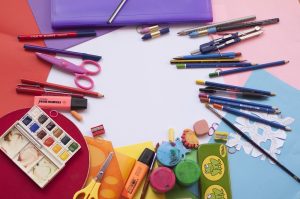Middle school represents the second step of a student’s academic journey. Middle school is meant to challenge individuals and help them develop vital skills like critical thinking, abstract reasoning, public speaking and leadership. These important skills will be covered along with numerous other topics in order to challenge our students and prepare them for the rigors of high school learning. We plan to do this by implementing a highly developed curriculum that will cover all of the essential middle school subjects (e.g. Math, Science, Social Studies and English) while also continuing to build on the student’s Islamic knowledge and expand it with Fiqh, Hadith, Seerah, Islamic History, Arabic Language, Akhlaq/Tarbia and Tafseer & Translation.
Middle school is also a time when a student begins to discover their strengths and passions. In order to promote this process our staff and administration have designed an incredibly diverse extracurricular program, which will introduce students to a number of new and exciting activities. These activities will include everything from learning the basic concepts but also implementing projects that use the learned concepts. Collectively these activities will give the student the rare opportunity to learn outside of the classroom in a fun and engaging environment.
Our students will Insha’Allah have a unique middle school experience that will give them a well rounded education and a competitive edge as they continue their academic careers.
Our students will Insha’Allah have a unique middle school experience that will give them a well rounded education and a competitive edge as they continue their academic careers.
The middle school program at Nova Elm Academy (NEA) is comprised of classes from the sixth grade to the eighth grade.
Middle school teachers help students build on the fundamentals taught in elementary school and prepare students for the more difficult curriculum they will face in high school.
6th Grade
6th Grade Math Content:
1. Whole Numbers
2. Multiplication
3. Division
4. Exponents & Square Roots
5. Number Theory
6. Decimals
7. Fractions & Mixed Numbers
8. Integers
9. Operations with Integers
10. Mixed Operations
11. Rational Numbers
12. Problem Solving & Estimation
13. Ratios & Rates
14. Percents
15. Units of Measurement
16. Money, Coordinate Plane
17. Expressions & Properties
18. One Variable Equations
19. One Variable Inequalities
20. Two Variable Equations
21. Two-Dimensional Figures
22. Symmetry & Transformations
23. Geometric Measurements
24. Data & Graphs
25. Statistics
26. Probability
1. Whole Numbers
2. Multiplication
3. Division
4. Exponents & Square Roots
5. Number Theory
6. Decimals
7. Fractions & Mixed Numbers
8. Integers
9. Operations with Integers
10. Mixed Operations
11. Rational Numbers
12. Problem Solving & Estimation
13. Ratios & Rates
14. Percents
15. Units of Measurement
16. Money, Coordinate Plane
17. Expressions & Properties
18. One Variable Equations
19. One Variable Inequalities
20. Two Variable Equations
21. Two-Dimensional Figures
22. Symmetry & Transformations
23. Geometric Measurements
24. Data & Graphs
25. Statistics
26. Probability
6th Grade Science Content:
1. Science Practices & Tools
2. Designing Experiments
3. Engineering Practices
4. Matter & Mass
5. Atoms & Molecules
6. Chemical Reactions
7. Velocity
8. Acceleration & Forces
9. Kinetic & Potential Energy
10. Thermal Energy
11. Particle Motion & Energy
12. Waves
13. Solutions
14. Classification & Scientific Names
15. Biochemistry
16. Cells
17. Anatomy & Physiology
18. Genes to Traits
19. Adaptation & Natural Selection
20. Fossils
21. Plant Reproduction
22. Photosynthesis
23. Ecosystems
24. Ecological Interactions
25. Conservation
26. Natural Resources & Human Impact
27. Rocks & Minerals
28. Plate Tectonics
29. Topographic Maps
30. Water Cycle
31. Weather & Climate
32. Climate Change
33. Natural Hazards
34. Astronomy
35. Units & Measurement
1. Science Practices & Tools
2. Designing Experiments
3. Engineering Practices
4. Matter & Mass
5. Atoms & Molecules
6. Chemical Reactions
7. Velocity
8. Acceleration & Forces
9. Kinetic & Potential Energy
10. Thermal Energy
11. Particle Motion & Energy
12. Waves
13. Solutions
14. Classification & Scientific Names
15. Biochemistry
16. Cells
17. Anatomy & Physiology
18. Genes to Traits
19. Adaptation & Natural Selection
20. Fossils
21. Plant Reproduction
22. Photosynthesis
23. Ecosystems
24. Ecological Interactions
25. Conservation
26. Natural Resources & Human Impact
27. Rocks & Minerals
28. Plate Tectonics
29. Topographic Maps
30. Water Cycle
31. Weather & Climate
32. Climate Change
33. Natural Hazards
34. Astronomy
35. Units & Measurement
6th Grade Science Content:
1. Prehistory
2. Ancient Mesopotamia
3. Ancient Egypt & Kush
4. Early China 5. Ancient South Asia
6. Comparing Ancient River Civilizations
7. The Silk Road
8. World Religions
9. Greece
10. Rome & the Byzantine Empire
11. Islamic Empires
12. African Empires
13. Medieval Asia
14. Medieval Europe
15. Early Modern Europe
16. Early Americas
17. Age of Exploration
18. Physical Geography
19. Europe: Geography
20. Africa: Geography
21. The Middle East: Society & Environment
22. Asia: Society & Environment
23. Asia: Geography
24. Oceania
25. Government
26. The Constitution
27. The Legal System
28. Citizenship
29. Basic Economic Principles
30. Banking & Finance
31. Supply & Demand
32. Social Studies Skills
1. Prehistory
2. Ancient Mesopotamia
3. Ancient Egypt & Kush
4. Early China 5. Ancient South Asia
6. Comparing Ancient River Civilizations
7. The Silk Road
8. World Religions
9. Greece
10. Rome & the Byzantine Empire
11. Islamic Empires
12. African Empires
13. Medieval Asia
14. Medieval Europe
15. Early Modern Europe
16. Early Americas
17. Age of Exploration
18. Physical Geography
19. Europe: Geography
20. Africa: Geography
21. The Middle East: Society & Environment
22. Asia: Society & Environment
23. Asia: Geography
24. Oceania
25. Government
26. The Constitution
27. The Legal System
28. Citizenship
29. Basic Economic Principles
30. Banking & Finance
31. Supply & Demand
32. Social Studies Skills
6th Grade Science Content:
Reading:
1. Main Idea
2. Theme
3. Author’s Purpose & Tone
4. Text Structure
5. Literary Devices
6. Analyzing Literature
7. Analyzing Informational Texts
8. Comparing Texts
9. Visual Elements
Writing:
1. Organizing Writing
2. Developing & Supporting Arguments
3. Creative Techniques
4. Editing & Revising
5. Citations
Vocabulary:
1. Prefixes & Suffixes
2. Greek & Latin Roots
3. Synonyms & Antonyms
4. Homophones
5. Idioms & Adages
6. Shades of Meaning
7. Analogies
8. Context Clues
9. Reference Skills
Grammar:
1. Sentences
2. Fragments & Run-Ons
3. Nouns
4. Pronouns & Antecedents
5. Pronoun Types
6. Verb Types
7. Subject-Verb Agreement
8. Verb Tense
9. Adjectives & Adverbs
10. Prepositions
11. Direct & Indirect Objects
12. Conjunctions
13. Contractions
14. Punctuation
15. Capitalization
16. Formatting
Reading:
1. Main Idea
2. Theme
3. Author’s Purpose & Tone
4. Text Structure
5. Literary Devices
6. Analyzing Literature
7. Analyzing Informational Texts
8. Comparing Texts
9. Visual Elements
Writing:
1. Organizing Writing
2. Developing & Supporting Arguments
3. Creative Techniques
4. Editing & Revising
5. Citations
Vocabulary:
1. Prefixes & Suffixes
2. Greek & Latin Roots
3. Synonyms & Antonyms
4. Homophones
5. Idioms & Adages
6. Shades of Meaning
7. Analogies
8. Context Clues
9. Reference Skills
Grammar:
1. Sentences
2. Fragments & Run-Ons
3. Nouns
4. Pronouns & Antecedents
5. Pronoun Types
6. Verb Types
7. Subject-Verb Agreement
8. Verb Tense
9. Adjectives & Adverbs
10. Prepositions
11. Direct & Indirect Objects
12. Conjunctions
13. Contractions
14. Punctuation
15. Capitalization
16. Formatting
7th Grade
7th Grade Science Content:
1. Science Practices & Tools
2. Designing Experiments
3. Engineering Practices
4. Density, Atoms & Molecules
5. Chemical Reactions
6. Velocity
7. Acceleration & Forces
8. Kinetic & Potential Energy
9. Thermal Energy
10. Particle Motion & Energy
11. Waves
12. Solutions
13. Classification & Scientific Names
14. Biochemistry
15. Cells
16. Anatomy & Physiology
17. Genes to Traits
18. Adaptations & Natural Selection
19. Fossils
20. Plant Reproduction
21. Photosynthesis
22. Ecosystems
23. Ecological Interactions
24. Conservation
25. Natural Resources & Human Impacts
26. Rocks & Minerals
27. Plate Tectonics
28. Topographic Maps
29. Water Cycle
30. Weather Climate
31. Climate Change
32. Natural Hazards
33. Astronomy
34. Units & Measurement
1. Science Practices & Tools
2. Designing Experiments
3. Engineering Practices
4. Density, Atoms & Molecules
5. Chemical Reactions
6. Velocity
7. Acceleration & Forces
8. Kinetic & Potential Energy
9. Thermal Energy
10. Particle Motion & Energy
11. Waves
12. Solutions
13. Classification & Scientific Names
14. Biochemistry
15. Cells
16. Anatomy & Physiology
17. Genes to Traits
18. Adaptations & Natural Selection
19. Fossils
20. Plant Reproduction
21. Photosynthesis
22. Ecosystems
23. Ecological Interactions
24. Conservation
25. Natural Resources & Human Impacts
26. Rocks & Minerals
27. Plate Tectonics
28. Topographic Maps
29. Water Cycle
30. Weather Climate
31. Climate Change
32. Natural Hazards
33. Astronomy
34. Units & Measurement
7th Grade Math Content:
1. Number Theory
2. Integers
3. Operations with Integers
4. Decimals
5. Operations with Decimals
6. Fractions & Mixed Numbers
7. Operations with Fractions
8. Rational Numbers
9. Exponents & Square Roots
10. Ratios
11. Rates & Proportions
12. Proportional Relationships
13. Percents
14. Consumer Math
15. Problem Solving & Estimation
16. Units of Measurement
17. Coordinate Plane
18. Expressions & Properties
19. One-Variable Equations
20. One-Variable Inequalities
21. Two-Variable Equations
22. Linear Functions
23. Two-Dimensional Figures
24. Transformation & Congruence
25. Pythagorean Theorem
26. Three-Dimensional Figures
27. Geometric Measurements
28. Data & Graphs
29. Statistics
30. Probability
1. Number Theory
2. Integers
3. Operations with Integers
4. Decimals
5. Operations with Decimals
6. Fractions & Mixed Numbers
7. Operations with Fractions
8. Rational Numbers
9. Exponents & Square Roots
10. Ratios
11. Rates & Proportions
12. Proportional Relationships
13. Percents
14. Consumer Math
15. Problem Solving & Estimation
16. Units of Measurement
17. Coordinate Plane
18. Expressions & Properties
19. One-Variable Equations
20. One-Variable Inequalities
21. Two-Variable Equations
22. Linear Functions
23. Two-Dimensional Figures
24. Transformation & Congruence
25. Pythagorean Theorem
26. Three-Dimensional Figures
27. Geometric Measurements
28. Data & Graphs
29. Statistics
30. Probability
7th Grade Science Content:
Reading:
1. Main Idea
2. Theme
3. Author’s Purpose & Tone
4. Text Structure
5. Literary Devices
6. Analyzing Literature
7. Analyzing Informational Texts
8. Comparing Texts
9. Visual Elements
Writing:
1. Organizing Writing
2. Developing & Supporting Arguments
3. Creative Techniques
4. Editing & Revising
5. Citations
Vocabulary:
1. Prefixes & Suffixes
2. Greek & Latin Roots
3. Synonyms & Antonyms
4. Homophones
5. Idioms & Adages
6. Shades of Meaning
7. Analogies, Context Clues
8. Reference Skills
Grammar:
1. Sentences
2. Fragments & Run-Ons
3. Nouns
4. Pronouns & Antecedents
5. Pronoun Types
6. Verb Types
7. Subject-Verb Agreement
8. Verb Tense
9. Adjectives & Adverbs
10. Prepositions
11. Direct & Indirect Objects
12. Conjunctions
13. Misplaced Modifiers
14. Restrictive & Non-Restrictive Elements
15. Commas
16. Semicolons
17. Colons & Commas
18. Dashes
19. Hyphens & Ellipses
20. Capitalization
21. Formatting
Reading:
1. Main Idea
2. Theme
3. Author’s Purpose & Tone
4. Text Structure
5. Literary Devices
6. Analyzing Literature
7. Analyzing Informational Texts
8. Comparing Texts
9. Visual Elements
Writing:
1. Organizing Writing
2. Developing & Supporting Arguments
3. Creative Techniques
4. Editing & Revising
5. Citations
Vocabulary:
1. Prefixes & Suffixes
2. Greek & Latin Roots
3. Synonyms & Antonyms
4. Homophones
5. Idioms & Adages
6. Shades of Meaning
7. Analogies, Context Clues
8. Reference Skills
Grammar:
1. Sentences
2. Fragments & Run-Ons
3. Nouns
4. Pronouns & Antecedents
5. Pronoun Types
6. Verb Types
7. Subject-Verb Agreement
8. Verb Tense
9. Adjectives & Adverbs
10. Prepositions
11. Direct & Indirect Objects
12. Conjunctions
13. Misplaced Modifiers
14. Restrictive & Non-Restrictive Elements
15. Commas
16. Semicolons
17. Colons & Commas
18. Dashes
19. Hyphens & Ellipses
20. Capitalization
21. Formatting
7th Grade Science Content:
1. Physical Geography
2. The Americas: Society & Environment
3. The Americas: Geography
4. Europe: Society & Environment
5. Europe: Geography
6. Africa: Society & Environment
7. Africa: Geography
8. The Middle East: Society & Environment
9. Asia: Society & Environment
10. Asia: Geography
11. Oceania: Geography
12. Prehistory, Ancient Mesopotamia
13. Ancient Egypt & Kush
14. Early China
15. Ancient South Asia
16. Comparing Ancient River Civilizations
17. The Silk Road
18. World Religions
19. Greece
20. Rome & the Byzantine Empire
21. Islamic Empires
22. African Empires
23. Medieval Asia
24. Medieval Europe
25. Early Modern Europe
26. Early Americas
27. Age of Exploration
28. Government
29. The Constitution
30., The Legal System
31. Citizenship
32. Basic Economic Principles
33. Banking & Finance
34. Supply & Demand
35. Colonial America
36. The American Revolution
37. The Early Republic
38. The Jacksonian Period
39. The Antebellum Period
40. The Civil War
41. Reconstruction
42. The Gilded Age
43. Social Studies Skills
1. Physical Geography
2. The Americas: Society & Environment
3. The Americas: Geography
4. Europe: Society & Environment
5. Europe: Geography
6. Africa: Society & Environment
7. Africa: Geography
8. The Middle East: Society & Environment
9. Asia: Society & Environment
10. Asia: Geography
11. Oceania: Geography
12. Prehistory, Ancient Mesopotamia
13. Ancient Egypt & Kush
14. Early China
15. Ancient South Asia
16. Comparing Ancient River Civilizations
17. The Silk Road
18. World Religions
19. Greece
20. Rome & the Byzantine Empire
21. Islamic Empires
22. African Empires
23. Medieval Asia
24. Medieval Europe
25. Early Modern Europe
26. Early Americas
27. Age of Exploration
28. Government
29. The Constitution
30., The Legal System
31. Citizenship
32. Basic Economic Principles
33. Banking & Finance
34. Supply & Demand
35. Colonial America
36. The American Revolution
37. The Early Republic
38. The Jacksonian Period
39. The Antebellum Period
40. The Civil War
41. Reconstruction
42. The Gilded Age
43. Social Studies Skills
8th Grade
8th Grade Science Content:
Reading:
1. Main Idea
2. Theme
3. Author’s Purpose & Tone
4. Text Structure
5. Literary Devices
6. Analyzing Literature
7. Analyzing Informational Texts
8. Comparing Texts
9. Visual Elements
Writing:
1. Organizing Writing
2. Developing & Supporting Arguments
3. Persuasive Strategies
4. Creative Techniques
5. Active & Passive Voice
6. Editing & Revising
7. Citations
Vocabulary:
1. Prefixes & Suffixes
2. Greek & Latin Roots
3. Synonyms & Antonyms
4. Homophones
5. Idioms & Adages
6. Shades of Meaning
7. Analogies
8. Context Clues
9. Reference Skills
Grammar:
1. Sentences
2. Fragments & Run-Ons
3. Phrases & Clauses
4. Pronouns & Nouns
5. Antecedents
6. Pronoun Types
7. Verb Types
8. Subject-Verb Agreement
9. Verb Tense
10. Adjectives & Adverbs
11. Prepositions
12. Direct & Indirect Objects
13. Conjunctions
14. Misplaced Modifiers
15. Restrictive & Non-Restrictive Elements
16. Commas
17. Semicolons
18. Colons & Commas
19. Dashes
20. Hyphens & Ellipses
21. Capitalization
22. Formatting
Reading:
1. Main Idea
2. Theme
3. Author’s Purpose & Tone
4. Text Structure
5. Literary Devices
6. Analyzing Literature
7. Analyzing Informational Texts
8. Comparing Texts
9. Visual Elements
Writing:
1. Organizing Writing
2. Developing & Supporting Arguments
3. Persuasive Strategies
4. Creative Techniques
5. Active & Passive Voice
6. Editing & Revising
7. Citations
Vocabulary:
1. Prefixes & Suffixes
2. Greek & Latin Roots
3. Synonyms & Antonyms
4. Homophones
5. Idioms & Adages
6. Shades of Meaning
7. Analogies
8. Context Clues
9. Reference Skills
Grammar:
1. Sentences
2. Fragments & Run-Ons
3. Phrases & Clauses
4. Pronouns & Nouns
5. Antecedents
6. Pronoun Types
7. Verb Types
8. Subject-Verb Agreement
9. Verb Tense
10. Adjectives & Adverbs
11. Prepositions
12. Direct & Indirect Objects
13. Conjunctions
14. Misplaced Modifiers
15. Restrictive & Non-Restrictive Elements
16. Commas
17. Semicolons
18. Colons & Commas
19. Dashes
20. Hyphens & Ellipses
21. Capitalization
22. Formatting
8th Grade Science Content:
1. Government
2. The Constitution
3. The Legal System
4. Citizenship
5. Basic Economic Principles
6. Banking & Finance
7. Early Modern Europe
8. Age of Exploration
9. Colonial America
10. The American Revolution
11. The Early Republic
12. The Jacksonian Period
13. The Antebellum Period
14. The Civil War
15. Reconstruction
16. The Gilded Age
17. Social Studies Skills
18. Physical Geography
19. The Americas: Society & Environment
20. The Americas: Geography
21. Europe: Society & Environment
22. Europe: Geography
23. Africa: Society & Environment
24. Africa: Geography
25. The Middle East: Society & Environment
26. Asia: Society & Environment
27. Asia: Geography
28. Oceania: Geography
1. Government
2. The Constitution
3. The Legal System
4. Citizenship
5. Basic Economic Principles
6. Banking & Finance
7. Early Modern Europe
8. Age of Exploration
9. Colonial America
10. The American Revolution
11. The Early Republic
12. The Jacksonian Period
13. The Antebellum Period
14. The Civil War
15. Reconstruction
16. The Gilded Age
17. Social Studies Skills
18. Physical Geography
19. The Americas: Society & Environment
20. The Americas: Geography
21. Europe: Society & Environment
22. Europe: Geography
23. Africa: Society & Environment
24. Africa: Geography
25. The Middle East: Society & Environment
26. Asia: Society & Environment
27. Asia: Geography
28. Oceania: Geography
8th Grade Math Content:
1. Number Theory
2. Integers
3. Operations with Integers
4. Decimals
5. Operations with Decimals
6. Fractions & Mixed Numbers
7. Operations with Fractions
8. Rational Numbers
9. Exponents & Square Roots
10. Scientific Notation
11. Ratios
12. Rates & Proportions
13. Proportional Relationships
14. Percents
15. Consumer Math
16. Problem Solving & Estimation
17. Units of Measurement
18. Problem Solving
19. Coordinate Plane
20. Expressions & Properties
21. One-Variable Equations
22. One-Variable Inequalities
23. Two-Variable Equations
24. Linear Equations
25. Functions
26. Two-Dimensional Figures
27. Transformation & Congruence
28. Transformation & Similarity
29. Pythagorean Theorem
30. Three-Dimensional Figures
31. Geometric Measurements
32. Number Sequence
33. System of Linear Equations
34. Monomials & Polynomials
35. Data & Graphs
36. Statistics
37. Probability
1. Number Theory
2. Integers
3. Operations with Integers
4. Decimals
5. Operations with Decimals
6. Fractions & Mixed Numbers
7. Operations with Fractions
8. Rational Numbers
9. Exponents & Square Roots
10. Scientific Notation
11. Ratios
12. Rates & Proportions
13. Proportional Relationships
14. Percents
15. Consumer Math
16. Problem Solving & Estimation
17. Units of Measurement
18. Problem Solving
19. Coordinate Plane
20. Expressions & Properties
21. One-Variable Equations
22. One-Variable Inequalities
23. Two-Variable Equations
24. Linear Equations
25. Functions
26. Two-Dimensional Figures
27. Transformation & Congruence
28. Transformation & Similarity
29. Pythagorean Theorem
30. Three-Dimensional Figures
31. Geometric Measurements
32. Number Sequence
33. System of Linear Equations
34. Monomials & Polynomials
35. Data & Graphs
36. Statistics
37. Probability
8th Grade Science Content:
1. Science Practices & Tools
2. Designing Experiments
3. Engineering Practices
4. Density
5. Atoms & Molecules
6. Chemical Reactions
7. Velocity
8. Acceleration & Forces
9. Kinetic & Potential Energy
10. Thermal Energy
11. Particle Motion & Energy
12. Waves
13. Solutions
14. Classification & Scientific Names
15. Biochemistry
16. Cells
17. Anatomy & Physiology
18. Genes to Traits
19. Adaptations & Natural Selection
20. Fossils
21. Plant Reproduction
22. Photosynthesis
23. Ecosystems
24. Ecological Interactions
25. Conservation
26. Natural Resources & Human Impacts
27. Rocks & Minerals
28. Plate Tectonics
29. Topographic Maps
30. Water Cycle
31. Weather Climate
32. Climate Change
33. Natural Hazards
34. Astronomy
35. Units & Measurement
1. Science Practices & Tools
2. Designing Experiments
3. Engineering Practices
4. Density
5. Atoms & Molecules
6. Chemical Reactions
7. Velocity
8. Acceleration & Forces
9. Kinetic & Potential Energy
10. Thermal Energy
11. Particle Motion & Energy
12. Waves
13. Solutions
14. Classification & Scientific Names
15. Biochemistry
16. Cells
17. Anatomy & Physiology
18. Genes to Traits
19. Adaptations & Natural Selection
20. Fossils
21. Plant Reproduction
22. Photosynthesis
23. Ecosystems
24. Ecological Interactions
25. Conservation
26. Natural Resources & Human Impacts
27. Rocks & Minerals
28. Plate Tectonics
29. Topographic Maps
30. Water Cycle
31. Weather Climate
32. Climate Change
33. Natural Hazards
34. Astronomy
35. Units & Measurement
Our teachers utilize the Project Based Learning (PBL) method of teaching by introducing the essential concepts and then working on projects that use those concepts. Our outcomes are not merely based on retention but rather on applications through analyzing, evaluating, and creating solutions for real world problems. This solid foundation would furnish our elementary students with a basis for lifelong learning.
Through these courses our students are enlightened about the world in which they live, with an emphasis on project based learning in an environment that applies concepts to real-world problems and projects. Teachers work with students and parents to ensure that this partnership will result in a life-long commitment to education.
Through these courses our students are enlightened about the world in which they live, with an emphasis on project based learning in an environment that applies concepts to real-world problems and projects. Teachers work with students and parents to ensure that this partnership will result in a life-long commitment to education.

Project Based Learning (PBL) is a teaching method in which students gain knowledge and skills by working for an extended period of time to investigate and respond to an engaging and complex question, problem, or challenge.
- PBL provides opportunities for students to use technology.
- PBL promotes lifelong learning.
- PBL connects students and schools with the real world.
- PBL lends itself to formative and authentic assessment.
- PBL encourages students to be more engaged and learn actively.
- PBL builds skills for college, career, and life.
- PBL encourages imagination and creativity.
CORE SUBJECTS:
The basic essential core subjects of Math, Science, English, and Social Studies are required to be taken by all students. Its important that the students learn the fundamental skills in these subjects at an early age.
Mathematics
Middle school students explore more complex math topics, such as using fractions, decimals, and percentages to solve problems. Using their more complete understanding of basic math functions, they also memorize the order of operations, allowing them to complete larger problems involving multiplication, subtraction, addition, and division. By focusing on the principles of mathematics, teachers help students to understand patterns, relations, and functions in math. Students with effective teachers are able to represent and analyze a variety of patterns in the mathematical world using tables, graphs, and symbols.


English Language Arts
Middle school English focuses on improving reading and writing abilities by exploring more complex pieces of literature. During middle school, many students first become aware of famous and important authors, and begin to read their major works and contributions to the field of literature.
Teachers focus on exploring these novels and pieces of non-fiction to help facilitate the development of stronger interpretation and literacy skills. During middle school, many students for the first time are using more complex cognitive processes that let them interpret plot, character, and setting.
Social Studies
As middle school students begin to develop questions about the political world around them, they want answers as to why certain events happened, or how governments came to be. Social Studies class focuses on providing the answers to these questions in a context that will interest the students.
Strategies like role playing, interviews, mock trials, debates, and class governance are used to show students how ethics and morality have played a part in history. By exploring these areas, students develop critical thinking skills, and an understanding of the democratic values of the country.


English Language Arts
Middle school English focuses on improving reading and writing abilities by exploring more complex pieces of literature. During middle school, many students first become aware of famous and important authors, and begin to read their major works and contributions to the field of literature.
Teachers focus on exploring these novels and pieces of non-fiction to help facilitate the development of stronger interpretation and literacy skills. During middle school, many students for the first time are using more complex cognitive processes that let them interpret plot, character, and setting.



